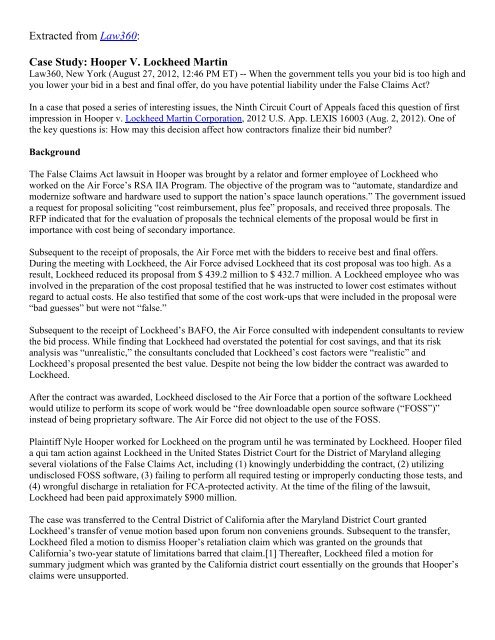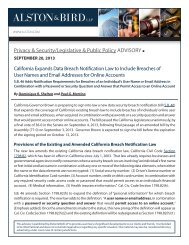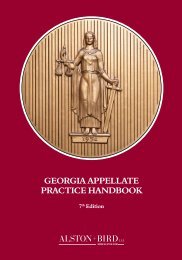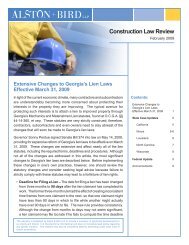Case Study: Hooper V. Lockheed Martin - Alston & Bird LLP
Case Study: Hooper V. Lockheed Martin - Alston & Bird LLP
Case Study: Hooper V. Lockheed Martin - Alston & Bird LLP
You also want an ePaper? Increase the reach of your titles
YUMPU automatically turns print PDFs into web optimized ePapers that Google loves.
Extracted from Law360:<br />
<strong>Case</strong> <strong>Study</strong>: <strong>Hooper</strong> V. <strong>Lockheed</strong> <strong>Martin</strong><br />
Law360, New York (August 27, 2012, 12:46 PM ET) -- When the government tells you your bid is too high and<br />
you lower your bid in a best and final offer, do you have potential liability under the False Claims Act?<br />
In a case that posed a series of interesting issues, the Ninth Circuit Court of Appeals faced this question of first<br />
impression in <strong>Hooper</strong> v. <strong>Lockheed</strong> <strong>Martin</strong> Corporation, 2012 U.S. App. LEXIS 16003 (Aug. 2, 2012). One of<br />
the key questions is: How may this decision affect how contractors finalize their bid number?<br />
Background<br />
The False Claims Act lawsuit in <strong>Hooper</strong> was brought by a relator and former employee of <strong>Lockheed</strong> who<br />
worked on the Air Force’s RSA IIA Program. The objective of the program was to “automate, standardize and<br />
modernize software and hardware used to support the nation’s space launch operations.” The government issued<br />
a request for proposal soliciting “cost reimbursement, plus fee” proposals, and received three proposals. The<br />
RFP indicated that for the evaluation of proposals the technical elements of the proposal would be first in<br />
importance with cost being of secondary importance.<br />
Subsequent to the receipt of proposals, the Air Force met with the bidders to receive best and final offers.<br />
During the meeting with <strong>Lockheed</strong>, the Air Force advised <strong>Lockheed</strong> that its cost proposal was too high. As a<br />
result, <strong>Lockheed</strong> reduced its proposal from $ 439.2 million to $ 432.7 million. A <strong>Lockheed</strong> employee who was<br />
involved in the preparation of the cost proposal testified that he was instructed to lower cost estimates without<br />
regard to actual costs. He also testified that some of the cost work-ups that were included in the proposal were<br />
“bad guesses” but were not “false.”<br />
Subsequent to the receipt of <strong>Lockheed</strong>’s BAFO, the Air Force consulted with independent consultants to review<br />
the bid process. While finding that <strong>Lockheed</strong> had overstated the potential for cost savings, and that its risk<br />
analysis was “unrealistic,” the consultants concluded that <strong>Lockheed</strong>’s cost factors were “realistic” and<br />
<strong>Lockheed</strong>’s proposal presented the best value. Despite not being the low bidder the contract was awarded to<br />
<strong>Lockheed</strong>.<br />
After the contract was awarded, <strong>Lockheed</strong> disclosed to the Air Force that a portion of the software <strong>Lockheed</strong><br />
would utilize to perform its scope of work would be “free downloadable open source software (“FOSS”)”<br />
instead of being proprietary software. The Air Force did not object to the use of the FOSS.<br />
Plaintiff Nyle <strong>Hooper</strong> worked for <strong>Lockheed</strong> on the program until he was terminated by <strong>Lockheed</strong>. <strong>Hooper</strong> filed<br />
a qui tam action against <strong>Lockheed</strong> in the United States District Court for the District of Maryland alleging<br />
several violations of the False Claims Act, including (1) knowingly underbidding the contract, (2) utilizing<br />
undisclosed FOSS software, (3) failing to perform all required testing or improperly conducting those tests, and<br />
(4) wrongful discharge in retaliation for FCA-protected activity. At the time of the filing of the lawsuit,<br />
<strong>Lockheed</strong> had been paid approximately $900 million.<br />
The case was transferred to the Central District of California after the Maryland District Court granted<br />
<strong>Lockheed</strong>’s transfer of venue motion based upon forum non conveniens grounds. Subsequent to the transfer,<br />
<strong>Lockheed</strong> filed a motion to dismiss <strong>Hooper</strong>’s retaliation claim which was granted on the grounds that<br />
California’s two-year statute of limitations barred that claim.[1] Thereafter, <strong>Lockheed</strong> filed a motion for<br />
summary judgment which was granted by the California district court essentially on the grounds that <strong>Hooper</strong>’s<br />
claims were unsupported.
The “False Estimate” Issue<br />
The Ninth Circuit upheld the district court’s dismissal of two of the three FCA claims involving the “untimely”<br />
disclosure of the use of FOSS software and failure to properly perform testing on the grounds that those claims<br />
were entirely lacking in evidentiary support. This left the question of whether <strong>Lockheed</strong>’s alleged false estimate<br />
was sufficient to constitute a claim under the FCA. While other circuits had decided the question, the court<br />
noted that it was a question of first impression in the Ninth Circuit.<br />
First, the court noted that in United States ex rel Marcus v. Hess, 317 U.S. 537 (1943), the Supreme Court found<br />
contractors liable under the FCA when they obtained a contract by collusive bidding. It noted that most courts<br />
interpreting Hess concluded that it stood for a “fraud in the inducement” theory of the FCA and therefore<br />
applied the FCA to bid-rigging cases. <strong>Lockheed</strong> argued that Hess and its progeny were distinguishable in that its<br />
bid could not be the basis for FCA liability because the cost proposal was an estimate — in essence a statement<br />
of opinion, as opposed to a statement of fact.<br />
The <strong>Hooper</strong> court reviewed decisions out of the First and Fourth Circuits which held that a false estimate, even<br />
based opinion, could be the basis of a false claim violation. It cited the Fourth Circuit Court’s decision in United<br />
States ex rel. Harrison v. Westinghouse Savannah River Co., 176 F.3d 766 (4th Cir. 1999), in which the<br />
defendant was alleged to have made false statements to obtain approval of a subcontract. It cited to the Fourth<br />
Circuit finding that even an opinion could establish liability for a false claim because “an opinion or estimate<br />
carries with it an ‘implied assertion, not only that the speaker knows no facts which would preclude such<br />
opinion, but that he does know facts which justify it.’”<br />
The court also endorsed the reasoning of the First Circuit’s opinion in Loughren v. Unum Group, 613 F. 3d 300,<br />
310-312 (1st Cir. 2010), where that court found that false statements on a social security application were false<br />
statements within the FCA so long as the applicants knew of facts that would reasonably preclude such an<br />
opinion.<br />
Based on these decisions, the court held: “we conclude that false estimates, defined to include fraudulent<br />
underbidding in which the bid is not what the defendant actually intends to charge, can be source of liability<br />
under the FCA, assuming that the other elements of a FCA are met.”<br />
Notwithstanding the court’s finding that a claim could be stated, the question remained whether the facts<br />
presented by plaintiff were sufficient to raise a material issue of fact as to whether <strong>Lockheed</strong>’s reduction of it<br />
proposal cost constituted a false claim. Here the court focused on the FCA alternative scienter requirements,<br />
i.e., whether (1) the defendant had actual knowledge of the falsity of the estimate, (2) the defendant acted in<br />
deliberate ignorance of the truth or falsity of the estimate, or (3) the defendant acted in reckless disregard of the<br />
truth or falsity of the estimate.[2]<br />
Turning to the facts of the case, the court highlighted testimony of a <strong>Lockheed</strong> employee who acknowledged<br />
that after the Air Force would not accept <strong>Lockheed</strong>’s original bid, he was instructed to change the cost without<br />
applying any engineering judgment. That same employee also testified that in connection with a bid on a<br />
separate contract, he was told to lower his cost notwithstanding that he had advised his superiors that his<br />
numbers represented the “real cost.”<br />
In addition, the court cited to the Air Force’s consultant’s contradictory findings that <strong>Lockheed</strong>’s bid was<br />
“unrealistic” in its assessment of risk but that it provided the “best overall value,” even with its problems. Based<br />
on these facts, the <strong>Hooper</strong> court concluded that a genuine material issue existed on the issue of whether<br />
<strong>Lockheed</strong> acted with knowledge, deliberate ignorance or reckless disregard that its estimate was false.
Commentary<br />
Obviously, the rub in this case is that <strong>Lockheed</strong> only reduced its proposal cost after the Air Force told <strong>Lockheed</strong><br />
that its costs were too high and that it would not accept <strong>Lockheed</strong>’s bid unless it was reduced.[3] While equity<br />
might argue against a finding of liability under these circumstances, FCA liability principally focuses on the<br />
defendant’s frame of mind in submitting a claim. While the government’s knowledge of the falsity of a<br />
representation may preclude FCA liability, the cases that address the “government knowledge” defense focus on<br />
the fact that the government’s knowledge was known to the defendant, thereby negating the existence of an<br />
intent to deceive. (Indeed, this was one of the grounds for the court upholding the district’s dismissal of<br />
plaintiff’s FOSS claim.)<br />
But this case presents a real dilemma to parties bidding on federal projects. For example, how often does a<br />
contractor perform a detailed workup of its estimate only to apply a percentage factor reduction to attempt to<br />
submit what it believes is a bid that is competitive? Doesn’t that happen all of the time when a bid is reviewed<br />
by management and adjusted to make it more competitive? The answer is that these kinds of bid adjustments<br />
happen all of the time and they are based upon very subjective factors which may not be subject to a<br />
mathematical calculation.<br />
However, it is doubtful that the <strong>Hooper</strong> decision will cause contractors to no longer adjust their bids.<br />
Competitive pressures on bidders are simply too great. However, at the very least, contractors will need to be<br />
able to make a showing that an adjustment is tied to some cost evaluation factor.<br />
--By Chris Roux, <strong>Alston</strong> & <strong>Bird</strong> <strong>LLP</strong><br />
Chris Roux is a partner in <strong>Alston</strong> & <strong>Bird</strong>'s Washington, D.C., and Los Angeles offices and co-chairman of the<br />
firm’s construction and government contracts group.<br />
The opinions expressed are those of the author and do not necessarily reflect the views of the firm, its clients, or<br />
Portfolio Media Inc., or any of its or their respective affiliates. This article is for general information purposes<br />
and is not intended to be and should not be taken as legal advice.<br />
[1] Because the federal FCA contains no express limitations period, courts borrow from the most analogous<br />
state statute of limitations. See Graham County Soil & Water Conservation Dist. V. U.S. ex rel Wilson, 545<br />
U.S. 409, 422 (2005). The Ninth Circuit reversed the district court’s dismissal of the retaliation claim on the<br />
grounds that the state statute of limitations which would have been applied by the transferor court was the<br />
appropriate limitations period to apply. In this case, Maryland had a three-year statute of limitations as opposed<br />
to California’s three-year limitations period.<br />
[2] The district court had ruled that since <strong>Lockheed</strong> did not knowingly make a false estimate, that it was not<br />
liable. The Ninth Circuit concluded that the district court applied an incorrect standard because it failed to<br />
consider the other two bases for establishing the requisite FCA scienter.<br />
[3] Another anomaly is that <strong>Lockheed</strong>’s cost was higher than at least some of the other bidders. Does that mean<br />
that other bidders also artificially reduced their proposals?







